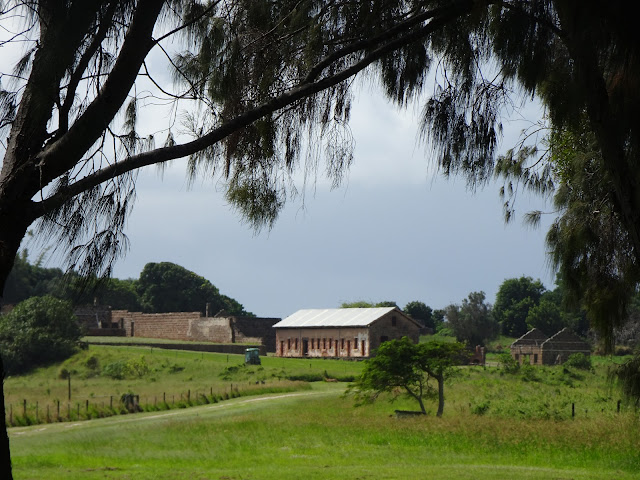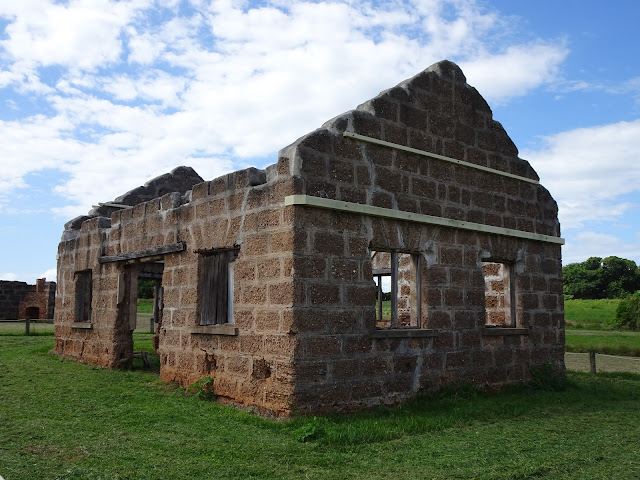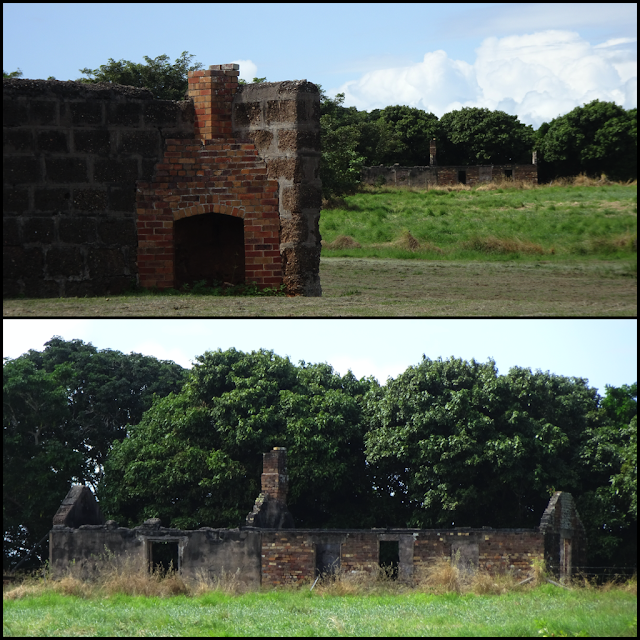Wednesday 13 April
St Helena Island is located in Moreton Bay, just 5 km from where Hungry Hiker Jenny lives. The Hungry Hikers have often looked into visiting to hike its foreshore, and although a National Park, we discovered that access is very limited. One can visit the island's southern foreshore if you have your own boat, but to explore the ruins, one is required to join a tour group. These are not frequent. A couple of months ago, I happened upon a 'Scoopon', or special discount voucher, and we booked to visit on the Wednesday before Easter. School holidays, so the boat was full. As we are all ex teachers, we were delighted to find it was a very pleasant group of 80, of mixed ages. The children in the group were enthralled by the stories our guides related.
Yes, we were "Glad we went and grateful we weren't sent!"
Our guides for the day were Prisoner 31 and his Warder. They escorted us to the island.
I doubt the warders would have presented like our man, but he was excellent in every other regard.
RHS top - the metal swimming enclosure for the warders.
The original buildings on St Helena were for a quarrantine station. Brisbane's gaols however, were overcrowded and so from 1867 to 1932, it functioned as a high-security colonial prison.
Leaving the pier, our surroundings were so peaceful it was difficult to imagine the harsh reality of life for the prisoners.
Our Warder for the day had us engrossed immediately, with his recounting of life on the island.
Initially named 'Green Island 2' [There were several so named] by explorer Matthew Flinders, it was renamed St Helena in 1827, when an Aborigine nicknamed Napolean, stole an axe on nearby Stradbroke Is. He was exiled to here, but quickly built himself a canoe and escaped. Interesting that 40 years later, St Helena was a prison.
View from the shore to the compound ruins.
Walking to the lime kiln I was taken by the structure of this tree, [still unnamed] and took a closer view. I was very surprised to see this wallaby in its shade and remaining calm on my approach.
From the outset, the prison was expected to be entirely self-sufficent.The prisoners built this lime kiln from locally collected beachrock and bricks. They were then made to collect coral and shells to burn in the kiln, to produce lime. The lime was then used as mortar and render for all the island buldings.
A short distance on, was the island cemeteries. One for the prisoners and one for the children of the warders. The warders and wives, if they passed away, were buried on the mainland. There are 17 known children buried here, but only 6 headstones remain.
A few metres away, the prisoners are identified only by the number issued to them on arrival on the island and not their name. Regardless of religion, they are all buried under a Christian cross. Their crimes ranged from murder, forgery and thieving to vagrancy.
It was time to take a walk through the fields that once grew sugar cane, crops of maize, luzerne, potatoes, vegetables and cattle, to visit the remains of the sugar mill.
The sugar cane was grown until the workshops for boot making, sail-making, tailoring, saddle making, tin smithing, candle making, book binding, and carpentry were completed and providing a good source of income for the Penal Establishment. Tradesmen, employed as prison warders ,supervised and maintained a high standard of workmanship and productivity. Apparently the system in place here were considered to be one of the best of its kind in the world.
From the sugar mill it was another stroll across the fields. Ayrshire dairy cattle had grazed here and had won awards at the Royal National Show and the island's olive groves yielded prize winning oil exhibited at shows in Italy.
Boathouse
Brick kiln, with the remains of a warder's home in the background.
Prisoner labour, on very poor rations and over long hours, was used for every aspect of island life. Our warder stressed time and again that the prison ran at a very large profit.
We walked through the remains of two cell blocks, kitchen, bakehouse, butcher, hospital, stables, storehouse, and the Superintendent's home.
View from the Superintendent's home.
One remaining, very old, olive tree. So wonderful to see.
An equally old frangapanie tree.
With mudflats and cruising sharks surrounding the island, escapes were not successful.
A small picnic lunch was served in individual baskets. Perfect, and enjoyed under the shade of mango trees.
As lunch came to an end, we witnessed the punishment of Prisoner 31 by the cat of nine tails. Perhaps not the best timing!
We then slowly made our way back through the stockade buildings to the pier, where our catamaran was waiting.
Goods were brought up from the pier on the tramway using manpower.
Here our warder is describing the cell conditions of the prisoners. Minimal space, either hot or cold and mosquito and sandfly ridden.
The fresh air and slow paced, but incredibly informative tour, had made for a wonderful day. The weather had also been perfect for our visit. We have left much wiser, but cannot begin to comprehend St Helena's reputation as 'the hell hole of the Pacific!'
I highly recommend this Cat-O'Nine-Tails, tour.
I wowuld love to read your comment.



































I wouldn't think visiting an old prison would be so interesting, but your post proves otherwise. Thanks for taking us readers along!
ReplyDeleteLinda, we thought we were visiting a 'convict prison' - the excesses of the British prisons from 1788 - 1868. This proved equally interesting.
DeleteThere's a residual sadness that radiates from these places-- But it was interesting, for sure.
ReplyDeleteIt was a visit of conflicting emotions. On hearing of all that was achieved, one felt positive but then, the negative was the often horrendous manner in which it was achieved. A total contrast to our penal system now.
DeleteFascinating tour. The prisoners learned skills there to take into the outside world anyway. That was a harsh sentence for vagrancy.
ReplyDeleteIt was Marie. On such a tranquil day it was difficult to imagine the harsh realities of prison life.
DeleteI'm glad you were able to snag tickets for the trip. One thing I was struck by was the "quarantine station" which came up in your story soon after the photo of you all in your masks. Perhaps we have a better understanding of quarantine these days. However, I'm sure we have no idea about the conditions that prisoners faced in those days. It sounds like a moving and informative tour.
ReplyDeleteYes Kim, the then and now! In the late 1800's the stations were to contain leprosy and in the early 1900's, the Spanish Flu.
DeleteFascinating place and what looked like a really well organised tour. Interesting to read that the prison ran at a significant profit
ReplyDeleteAnd its products were of a much sort after high standard.
ReplyDelete